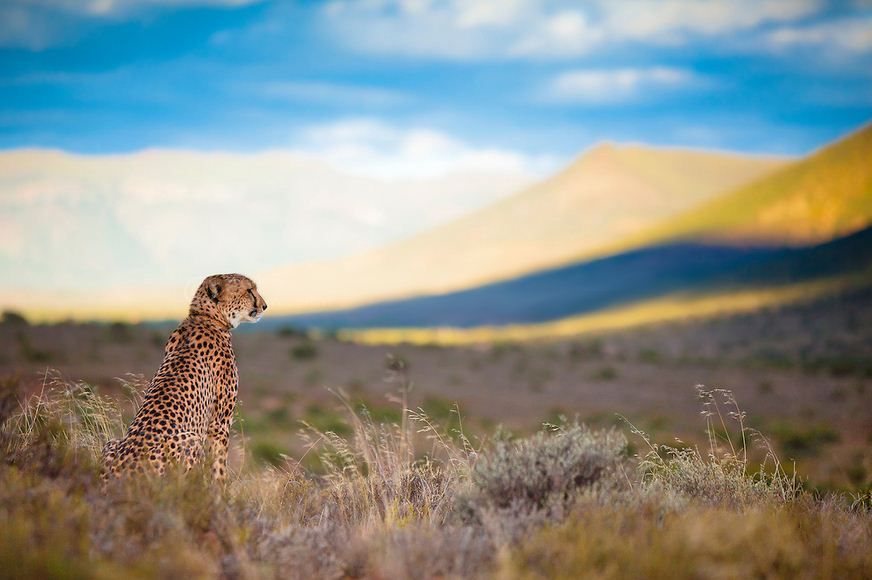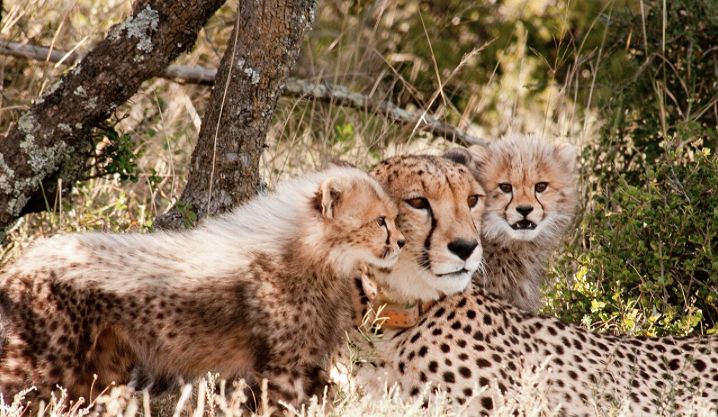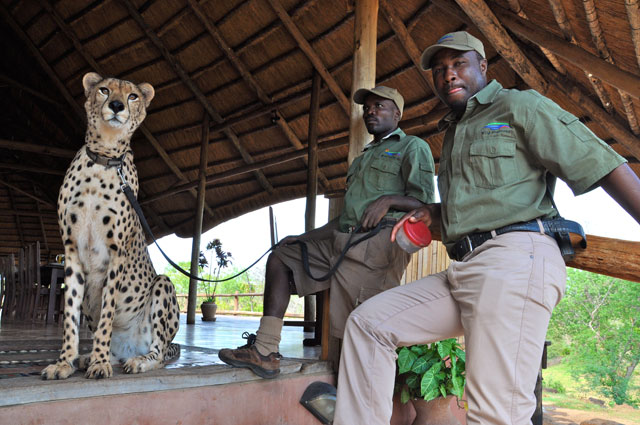Sibella & Silvester - cheetah ambassadors
True ambassadors for cheetah conservation
Sibella & Silvester
These are the stories of two cheetah who have found a semblence of fame and notoriety that has reflected back on their species in a positive way, both in educational terms and from a conservation perspective:
SIBELLA'S STORY
Born in South Africa’s North West province, Sibella’s life nearly ended at the hands of hunters. At two years of age she was set upon with hunting dogs who tore away all the flesh on her hind legs, a rope was forced roughly into her mouth, and she was savagely beaten and locked in a cage. Lying at death’s door, fear and mistrust haunting her eyes, she was fortunate enough to be rescued by the De Wildt Cheetah and Wildlife Trust. She owes her life to the five-hour surgery and dedicated rehabilitation that ensued.
In December 2003, Sibella began a new chapter when she was introduced onto Samara along with two male cheetah, also rescued from conflict with farmers. The three cheetah were placed in adjoining temporary enclosures to enable them to get used to each other and their new environment.
On 24th April 2004, Sibella was the first to be released into the wild - and the first cheetah back in the Karoo in 130 years.
From the moment of her release, all those involved in her rehabilitation waited anxiously to see whether she would be able to fend for herself, given her injuries and her trauma suffered at the hands of man. But we needn’t have worried. Sibella outlived most cheetah in the wild, dying of natural causes in 2015 at the ripe age of 14, proving herself to be a capable hunter despite the occasional twinge from her previous injuries.
Successfully rearing an astonishing 19 cubs in four litters since her release, she was also an exemplary mother – giving birth on steep mountain slopes to avoid potential predators and eating only after her young had had their fill. The unspoken bond she shared with the humans in her new home was extraordinary – with the birth of each new litter, when the cubs were old enough to leave their den, this wild cat dutifully presented to her human guardians her latest bundles of fur, the very reason for her existence.
This exceptional cat has done more than merely touch our hearts and allow us to marvel at her beauty. She is also a record-breaker of note, being the first cheetah back in the Karoo in 125 years, contributing 2.4% to the wild cheetah population in South Africa through her various litters, and featuring in dozens of magazines, newspapers and television programmes across the globe.
Although she is no longer, Sibella’s legacy and memory live on, both in the hearts of those lucky enough to have met her, and in the 15 protected areas across South Africa where her genes are now present. At the time of her death on 11th September 2015, Sibella was mother to 9, grandmother to 10 and great-grandmother to 18 cheetah still alive across the country. A truly remarkable cat.
Courtesey: Samara Gane Reserve, Eastern Cape South Africa.
Afterword: A documentary feature about Sibella by National Geographic has featured on Nat Geo Wild - A cheetah’s story: From tortured to treasured.
Go back to: Families & Species Ambassadors
SILVESTER'S STORY
Until early 2019 The Elephant Camp, a few kilometers outside of Victoria Falls in Zimbabwe, had been the home of another cheetah ambassador - Silvester. Here is his story:
In April 2010, in the Lowveld area of Zimbabwe, a cheetah gave birth to five cubs. Sadly within two days, in a cruel act of nature, she and four of her cubs were fatally attacked by a male lion, something which is common between apex predators in the wild. The sole survivor was discovered by a game scout named Sylvester, who witnessed the event and the cub was named after him by Norman and Penny English who became his surrogate parents. Norman worked in National Parks and Wildlife Management for many years and now heads the anti poaching unit in the Bubi Conservancy. Penny is a registered nurse and having both their experience was invaluable in the attempt to keep this young cheetah alive. At two days old, Sylvester still had his umbilical cord attached and unopened eyes.
Over the following six months the hard work and devotion from the English family was rewarded, but it did not come easily. Feeding was complicated and Sylvester grew faster than his bones could grow but the struggle to find a suitable formula was assisted by the many cheetah experts who passed on information. In time a dietary plan that suited Sylvester was formulated and he began to respond.
As Sylvester was never destined to become a pet, and being a specially protected animal on the endangered species list, the Department of National Parks and Wildlife Management had naturally been involved from the outset with Sylvester’s welfare. A plan needed to be formulated for a future permanent home for Sylvester, and in this regard the Victoria Falls Wildlife Trust (VFWT) became involved. Despite numerous release attempts, cheetah, apparently, do not survive in the wild without experiencing the maternal care of a mother for the initial twenty two months of their lives. The human imprints of upbringing in captivity are not conducive to a wild release with rehabilitated cheetah often coming into contact with human settlements and being seen as “problem” animals.
The Sanctuary that VFWT operates from has large areas of open grasslands where a cheetah can exercise naturally and build up the speed for which they are renowned. With no large predators around and the support from his three carers who exercise him extensively and assist in nurturing this orphan, Sylvester has settled in to his new life with vigour. Through our educational programme, Sylvester interacts with schoolchildren and guests who visit the Elephant Wallow during other activities. He will become an “ambassador” cheetah, interacting with the public to raise awareness of their peril as a species and the challenges they face being on the endangered species list.
Here in the Victoria Falls region, cheetah are a rare sighting and whilst VFWT respects that the ultimate aim is to promote the conservation of wildlife and are merely custodians of this magnificent animal, funds need to be raised for his upkeep. With feeding, exercise, care and constant companionship, Sylvester has already adapted perfectly to his new environment.
VICTORIA FALLS WILDLIFE TRUST ANNOUNCES PASSING OF CHEETAH AMBASSADOR SYLVESTER - Jessica Dawson, Executive Officer January 2019
I am deeply saddened to announce that Sylvester, our adored cheetah ambassador, passed away last night from injuries sustained during a confrontation with a small female leopard. Our entire Victoria Falls Wildlife Trust family, including visitors and supporters worldwide, will sorely miss our charismatic friend and companion. He touched thousands of hearts, transformed negative opinions about predators, like cheetahs, into positive ones and inspired us all to embrace and learn more about his amazing species. The outpouring of concern and support we have received from around the world is lifting us through this extremely difficult time.
The altercation between Sylvester and the leopard occurred on the evening of January 26th. Veterinarian Dr. Chris Foggin began treatment immediately, while Sylvester’s team of animal care specialists also worked around the clock to provide care and monitor his condition. Unfortunately, during the following days, his status deteriorated as his kidneys began to shut down, likely a result of the stress. With his team of devoted animal keepers by his side, he was euthanized last night at 8:15pm Zimbabwe time, 1:15 Eastern time in the U.S.
Sylvester is close to nine years old and came to the Trust as an orphan when a lion killed his mother and four siblings. Alone, hungry and dehydrated, Sylvester was discovered by a game scout who brought him to the English family at Bubye Valley Conservancy where he spent the next 6-months of his life. Norman English was ex-National Parks and Wildlife Management and Penny English was a registered nurse. Sylvester’s survival was a direct result of their skills, wildlife knowledge and care. Eventually, National Park authorities who then asked Victoria Falls Wildlife Trust for help. Given that a cheetah’s physiology and diet are very complex, our veterinary capacity and resources would ensure that Sylvester would thrive.
Unfortunately, by the time Sylvester came to the Trust, he was imprinted on people, thus making the chances for his successful release to the wild questionable at best. Most likely, he would have found comfort being around people, thereby causing problems in rural communal areas that surround our national parks in the Victoria Falls area. It is highly probable wildlife managers would have had to put him down. Because he was a specially protected animal on the endangered species list, National Parks and Wildlife Management and the Trust decided to give Sylvester a career as an ambassador animal to champion a message of coexistence with our rural and urban neighbors.
Research supports the fact that ambassador animals can provide compelling experiences needed for people to gain and maintain personal connections with their own relationships with nature. Such was the case with Sylvester: he was an impactful catalyst in the delivery of our conservation messages, which profoundly affect learning and promote attitudinal changes in the region.
Victoria Falls Wildlife Trust will continue Sylvester’s noble work of helping to steward a culture of coexistence with carnivores and fostering a conservation ethos among rural communities through education and outreach.
Courtesey Wild Horizons, Zimbabwe.
ARTICLES OF INTEREST:
Bewitched by the majesty of Karoo - from The Sunday Times by Nigel Tisdall January 2012.
A ONCE IN A LIFETIME ETHICAL CHEETAH ENCOUNTER from Christina's Travel Blog.



